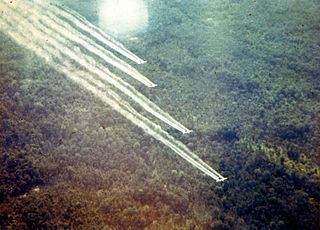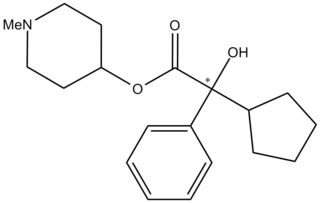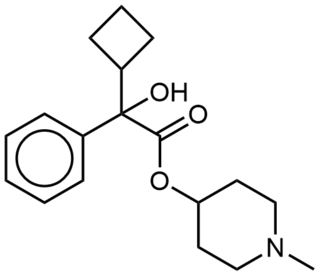Nerve agents, sometimes also called nerve gases, are a class of organic chemicals that disrupt the mechanisms by which nerves transfer messages to organs. The disruption is caused by the blocking of acetylcholinesterase (AChE), an enzyme that catalyzes the breakdown of acetylcholine, a neurotransmitter. Nerve agents are irreversible acetylcholinesterase inhibitors used as poison.
3-Quinuclidinyl benzilate (QNB) is an odorless and bitter-tasting military incapacitating agent. BZ is an antagonist of muscarinic acetylcholine receptors whose structure is the ester of benzilic acid with an alcohol derived from quinuclidine.
Incapacitating agent is a chemical or biological agent which renders a person unable to harm themselves or others, regardless of consciousness.

From 1948 to 1975, the U.S. Army Chemical Corps conducted classified human subject research at the Edgewood Arsenal facility in Maryland. The purpose was to evaluate the impact of low-dose chemical warfare agents on military personnel and to test protective clothing, pharmaceuticals, and vaccines. A small portion of these studies were directed at psychochemical warfare and grouped under the prosaic title of the "Medical Research Volunteer Program" (1956–1975). The MRVP was also driven by intelligence requirements and the need for new and more effective interrogation techniques.

The Rainbow Herbicides are a group of tactical-use chemicals used by the United States military in Southeast Asia during the Vietnam War. Success with Project AGILE field tests in 1961 with herbicides in South Vietnam was inspired by the British use of herbicides and defoliants during the Malayan Emergency in the 1950s, which led to the formal herbicidal program Trail Dust. Herbicidal warfare is the use of substances primarily designed to destroy the plant-based ecosystem of an agricultural food production and/or to destroy dense foliage which provides the enemy with natural tactical cover.

Dimethylheptylpyran is a synthetic analog of THC, which was invented in 1949 during attempts to elucidate the structure of Δ9-THC, one of the active components of Cannabis. DMHP is a pale yellow, viscous oil which is insoluble in water but dissolves in alcohol or non-polar solvents.

N-Methyl-3-piperidyl benzilate is an anticholinergic drug related to the chemical warfare agent 3-quinuclidinyl benzilate.

N-Ethyl-3-piperidyl benzilate (JB-318) is an anticholinergic drug related to the chemical warfare agent 3-Quinuclidinyl benzilate.

Ditran (JB-329) is an anticholinergic drug mixture, related to the chemical warfare agent 3-Quinuclidinyl benzilate (QNB).

EA-3167 is a potent and long-lasting anticholinergic deliriant drug, related to the chemical warfare agent 3-quinuclidinyl benzilate (QNB) and to the bronchodilator drug tiotropium bromide. It was developed under contract to Edgewood Arsenal during the 1960s as part of the US military chemical weapons program, in an attempt to develop non-lethal incapacitating agents. EA-3167 has identical effects to QNB, but is even more potent and longer-lasting, with an effective dose when administered by injection of as little as 2.5 μg/kg, and a duration of 120–240 hours. However unlike QNB, EA-3167 was never weaponized or manufactured in bulk.

EA-3443 is a potent and long lasting anticholinergic deliriant drug, related to the chemical warfare agent 3-Quinuclidinyl benzilate (QNB). It was developed under contract to Edgewood Arsenal during the 1960s as part of the US military chemical weapons program, during research to improve upon the properties of earlier agents such as QNB.

CAR-302,196 is a moderately potent and relatively short lasting anticholinergic deliriant drug, related to the chemical warfare agent 3-Quinuclidinyl benzilate (QNB). It was developed under contract to Edgewood Arsenal during the 1960s as part of the US military chemical weapons program, during research to improve upon the properties of earlier agents such as QNB.

EA-3580 is a potent anticholinergic deliriant drug with a fairly long duration of action, related to the chemical warfare agent 3-Quinuclidinyl benzilate (QNB). It was developed under contract to Edgewood Arsenal during the 1960s as part of the US military chemical weapons program, during research to improve upon the properties of earlier agents such as QNB.

CAR-226,086 is a potent anticholinergic deliriant drug with a fairly long duration of action, related to the chemical warfare agent 3-quinuclidinyl benzilate (QNB). It was developed under contract to Edgewood Arsenal during the 1960s as part of the US military chemical weapons program, during research to improve upon the properties of earlier agents such as QNB.

EA-3834 is a potent anticholinergic deliriant drug with a fairly long duration of action, related to the chemical warfare agent 3-quinuclidinyl benzilate (QNB). It was developed under contract to Edgewood Arsenal during the 1960s as part of the US military chemical weapons program, during research to improve upon the properties of earlier agents such as QNB.

EA-3148 is a "V-series" nerve agent related to the better-known compounds VX and VR. It was studied by both the US and Soviet chemical weapons programmes during the Cold War, and is notable as the only V-series organophosphate nerve agent specifically identified in public domain sources as having a higher absolute potency as an acetylcholinesterase inhibitor than VX. However, both the US and Soviet investigations of the compound concluded that despite its high potency, the physicochemical properties of the substance made it unsuitable for weaponisation, and further research was not conducted.

Cholinergic blocking drugs are a group of drugs that block the action of acetylcholine (ACh), a neurotransmitter, in synapses of the cholinergic nervous system. They block acetylcholine from binding to cholinergic receptors, namely the nicotinic and muscarinic receptors.

CAR-302,282 (302282, NSC-263548, α-(3-Methylbut-1-yn-3-enyl)mandelic acid 1-methyl-4-piperidyl ester) is an anticholinergic deliriant drug, invented under contract to Edgewood Arsenal in the 1960s. It is a potent incapacitating agent with an ED50 of 1.2μg/kg and a high central to peripheral effects ratio, and a relatively short duration of action compared to other similar drugs of around 6-10 hours. Despite its favorable properties it was relatively little researched compared to more high profile compounds from the series such as EA-3167 and EA-3580.

CAR-302,668 (302668, α-isopropylmandelic acid (1-methyl-1,2,3,6-tetrahydro-4-pyridyl)methyl ester) is an anticholinergic deliriant drug, invented under contract to Edgewood Arsenal in the 1960s. It is a reasonably potent incapacitating agent with an ED50 of 4μg/kg and a long duration of action of around 16-24 hours.

4-686-293-01, also known as Agent 1-10, is a highly potent experimental carbamate nerve agent, patented in May 1967. Due to its high molecular weight and thermal stability, it can remain embedded within various surfaces and clothes for prolonged periods of time. The agent can be decontaminated using bleach or hot caustic soda. The main effector pathway is through the inhibition and antagonization of acetylcholinesterase, achieved by the presence of quaternary ammonium groups in the structure. Perceived as one of the most potent agents in chemical warfare - it can be disseminated through aerosols, explosives or smoke generating munitions.

















